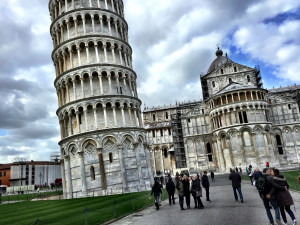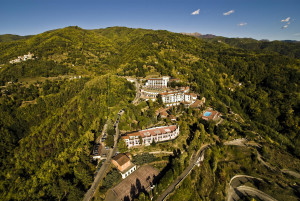 Looking for an unforgettable multi-gen vacation? Start with the fact that everyone loves Italy—the food, the culture, the people, and the landscape never fail to enchant. Add to this the quest for authenticity shared by boomers and millennials alike. Toss in a gorgeous hotel in relatively untraveled northern Tuscany, the Renaissance Tuscany Il Ciocco Resort & Spa, and you have the recipe to experience an unforgettable taste of authentic Italy.
Looking for an unforgettable multi-gen vacation? Start with the fact that everyone loves Italy—the food, the culture, the people, and the landscape never fail to enchant. Add to this the quest for authenticity shared by boomers and millennials alike. Toss in a gorgeous hotel in relatively untraveled northern Tuscany, the Renaissance Tuscany Il Ciocco Resort & Spa, and you have the recipe to experience an unforgettable taste of authentic Italy.
HOTEL HEAVEN
A 75-minute drive from Florence, the 180-room Renaissance Tuscany Il Ciocco is tucked away in a hilltop, gated estate overlooking the stunning Serchio Valley and Apuan mountains, a few miles from the medieval town of Barga. Northern Tuscany is less well known than Florence and the southern part of the region, especially to Americans. Here, it often feels like you’re stepping back in time, while simultaneously enjoying the comfort and modern conveniences of a first-rate hotel, including Wi-Fi—a perfect fit for the millennial mindset.
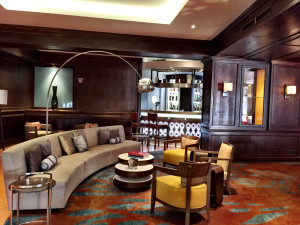 I loved snuggling into the super comfy Marriott bedding, not typically found in European hotels. The elegant Renaissance Tuscany also has two restaurants and a lounge, indoor and outdoor pools, and a first-rate spa with 12 treatment rooms and excellent therapists—a therapeutic massage is a great way to chill out after an active day in the beautiful countryside surrounding the property.
I loved snuggling into the super comfy Marriott bedding, not typically found in European hotels. The elegant Renaissance Tuscany also has two restaurants and a lounge, indoor and outdoor pools, and a first-rate spa with 12 treatment rooms and excellent therapists—a therapeutic massage is a great way to chill out after an active day in the beautiful countryside surrounding the property.
Among the many options for active travelers staying at the Renaissance Tuscany are walking the trails on property, hiking in the nearby wilderness park Parco dell’Orecchiella on the slopes of the Apennines mountains, and spelunking at the Grotto del Vento, a wind cave that descends over 7,000 feet. The friendly hotel staff will help you plan activities and recommend local guides, and don’t be shy about asking affable General Manager Georges Midleje to chat with you about the area: he is well connected with the local scene. Within the two-mile estate, Midleje recommends horseback riding, ATVing, and picnics.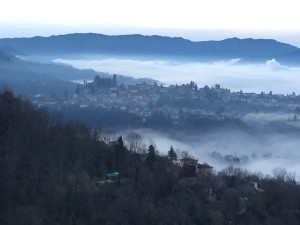
Tip: waking up in one of the 51 balcony suites with unobstructed views of the Apuan Mountains is a wow experience for even the most jaded traveler.
FOOD AND WINE
What could be more motivating than being in northern Tuscany? Answer: Eating in northern Tuscany. The farm-to-table food of this area is justifiably famous for being indescribably delicious, with such local specialties as spelt soup and pecorino sheep’s cheese topped with local honey. And of course, the pasta!
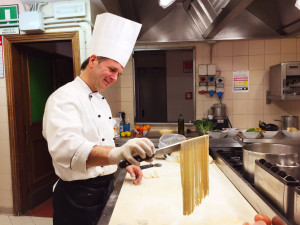 Everything you eat, in the hotel restaurants and beyond, will be fresh and local. The Slow Food movement—which preserves traditional, regional cuisine and encourages farming and livestock characteristic of the local ecosystem, is robust in this part of Italy.
Everything you eat, in the hotel restaurants and beyond, will be fresh and local. The Slow Food movement—which preserves traditional, regional cuisine and encourages farming and livestock characteristic of the local ecosystem, is robust in this part of Italy.
Don’t miss a visit to the Saturday morning farmer’s market in Barga, where farmers sell their just-picked fruit and veggies. You may even be able to sign up for a culinary experience with the hotel chefs using some of this fresh market fare. My multi-gen group selected an array of goodies and then repaired to the hotel kitchen to work with the chefs, cooking up a vegetarian feast of spinach ravioli, 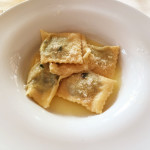 eggplant parmesan, fried zucchini sticks, and steamed broccoli and string beans—plus tiramisu and a fresh fruit tart for dessert. YUM.
eggplant parmesan, fried zucchini sticks, and steamed broccoli and string beans—plus tiramisu and a fresh fruit tart for dessert. YUM.
Another must-do activity for foodies is a visit to the small store and family-style eatery Il Vecchio Mulino in the medieval village of Castelnuovo di Garfagnana, where popular proprietor Andrea slices whole legs of cured Prosciutto hams, served up with such other regional fare as potato bread (Pane di Patate) and blood sausage (Biroldo). The shelves here are stocked with small jars of specialties that make great gifts, such as tiny caviar-like balls of balsamic vinegar that pop with flavor when used as a garnish.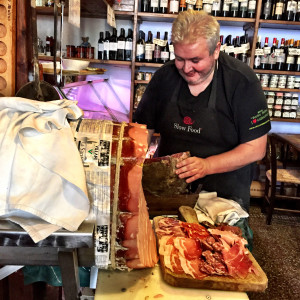
Meeting local characters like Andrea—and the friendly folks who frequent his restaurant, from Italian tourists to the town’s mayor—is part of what makes this region of northern Tuscany special. We saw Andrea again at the biodynamic winery Podere Concori, where local vintner Gabriele produces five varieties of organic Tuscan wines the old-fashioned way, using such fresh herbs as valerian, chamomile, stinging nettles, fennel, and dandelion. Gabriele is a passionate advocate of traditional winemaking, from manually stomping the grapes to bottling the wines according to the rhythms of the moon. Your visit to Podere Concori 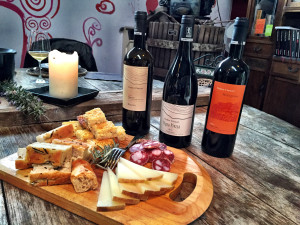 includes an intimate and informational tour of the hillside vineyard and of course tastings of the delicious wines paired with local food. Producing about 12,000 bottles yearly, Podere Concori wines are gaining critical recognition. But the best part of visiting the beautiful small vineyard is that you feel like you are living local; learning about biodynamic winemaking from Gabriele and his family, then joining the family for food, drink, and animated conversation in true Italian fashion. Tip: I was so impressed with the Podere Concori wines that I had a dozen bottles shipped home.
includes an intimate and informational tour of the hillside vineyard and of course tastings of the delicious wines paired with local food. Producing about 12,000 bottles yearly, Podere Concori wines are gaining critical recognition. But the best part of visiting the beautiful small vineyard is that you feel like you are living local; learning about biodynamic winemaking from Gabriele and his family, then joining the family for food, drink, and animated conversation in true Italian fashion. Tip: I was so impressed with the Podere Concori wines that I had a dozen bottles shipped home.
BARGA, LUCCA, AND PISA
Active travelers can walk about two miles from the Renaissance Tuscany to visit the picturesque town of Barga. In its heyday, this gated medieval city was a stronghold of The Medici’s Florence. Today, it retains its charm in an historic center characterized by narrow alleys and flights of steps leading to irregularly shaped ancient buildings, beautiful old houses, and tiny shops. Barga is a wonderful walking town, best seen on foot.
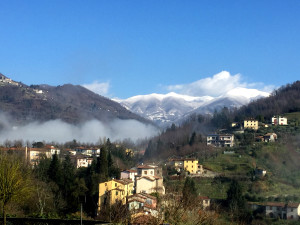 After climbing the steep steps in Barga’s historic center, you’ll be rewarded with breathtaking views. Wandering the streets here feels like you’ve been transported back in time to unspoiled Italy. You can easily spend several hours exploring—and of course, eating.
After climbing the steep steps in Barga’s historic center, you’ll be rewarded with breathtaking views. Wandering the streets here feels like you’ve been transported back in time to unspoiled Italy. You can easily spend several hours exploring—and of course, eating.
Our immersion into the history, food, and architecture of northern Tuscany also included visits to the cities of Pisa and Lucca, and to attractions in the nearby countryside. Stop at the Fattoria del Teso winery in Montecarlo for a delicious wine-tasting lunch al fresco or at rustic wood tables surrounded by oak barrels of fermenting wine, while chowing down on typical Tuscan cuisine.
And don’t miss a visit to the 14th century Devil’s Bridge for a photo op over vivid turquoise waters.  It is one of those painterly, historic spots that takes your breath away and brings you to another time and place. You can still feel the long-ago vibes of the medieval pilgrims who crossed this bridge over the Serchio river, and it’s an amazing example of ancient engineering. Devil’s Bridge—Ponte della Maddalena—is a convenient stop from the Renaissance Tuscany en-route to either Pisa or Lucca.
It is one of those painterly, historic spots that takes your breath away and brings you to another time and place. You can still feel the long-ago vibes of the medieval pilgrims who crossed this bridge over the Serchio river, and it’s an amazing example of ancient engineering. Devil’s Bridge—Ponte della Maddalena—is a convenient stop from the Renaissance Tuscany en-route to either Pisa or Lucca.
Arriving in Pisa, it’s fascinating to explore the imposing striped-marble cathedral and iconic Leaning Tower of Pisa built in 1372. We discovered a little-known gem just a short walk away from the main tourist attractions when our guide took us to the University of Pisa’s Knights’ Square. Founded in 1343 and distinguished by gorgeous Renaissance architecture, the university bustles with modern student life.
While not as well known as Florence or Pisa, the walled city of Lucca was one of Italy’s most powerful medieval cities, and the birthplace of the composer Puccini. Today, it hums with multigenerational energy as people bicycle and stroll the pedestrian promenade atop the city walls; explore the beautiful town squares with architecture that dates from the 12th century; shop the charming stores and crafts market; and get pure drinking water from the ancient stone fountains. As in everywhere in northern Tuscany, there are many excellent restaurants in Lucca. For atmosphere and refined regional cuisine, go to La Buca di Sant’Antonio, where a gleaming collection of antique copper pots (and the occasional musical instrument) hang from the wood-beamed ceilings that date to the 18th century, and old-world waiters serve such specialties as roasted goat that melts from the bone.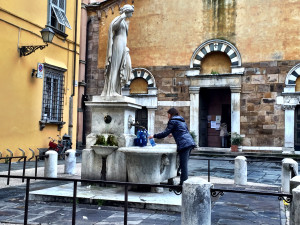
Tip: Summer is festival time in Italy. The July music festival in Lucca and August jazz festival in Barga draw top artists. But to experience Italy unfiltered, visit in the off-seasons when there are fewer tourists.
IF YOU GO
Florence International airport is served by many major airlines. If you’ve never been to Florence, don’t miss spending a few days there before heading north. The Renaissance Tuscany is located about 60 miles away. If you’re not renting a car, the hotel can arrange airport transfers and pick-up, or you can take the train to Barga-Galliciano station where it’s a 10 minute taxi ride to the resort.


